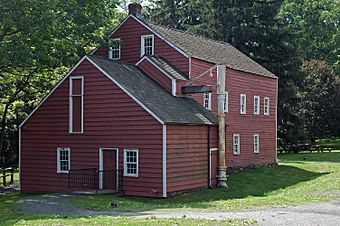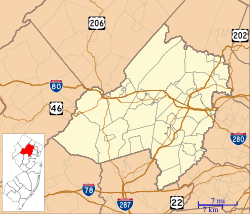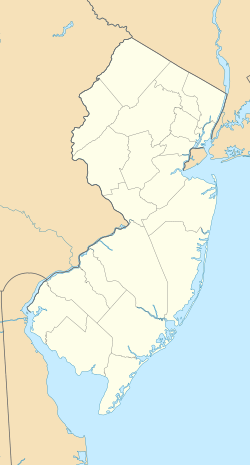Speedwell Ironworks facts for kids
|
The Factory, Speedwell Village
|
|

The Factory House, birthplace of the Morse electric telegraph, pictured in 2006
|
|
| Location | 333 Speedwell Avenue, Morristown, New Jersey |
|---|---|
| Built | 1837 |
| NRHP reference No. | 74001186 |
Quick facts for kids Significant dates |
|
| Added to NRHP | September 13, 1974 |
| Designated NHL | May 30, 1974 |
Speedwell Ironworks was a very important factory in Speedwell Village, New Jersey. It was a place where people made things out of iron. This historic site is famous because it's where two brilliant inventors, Alfred Vail and Samuel Morse, first showed off their amazing electric telegraph. Imagine sending messages over long distances almost instantly – that was a huge deal back then!
Speedwell Ironworks also played a big part in building the SS Savannah. This ship was the first steamship to ever cross the Atlantic Ocean. Today, you can visit this special place, now called Historic Speedwell. It's a historic site managed by the Morris County Park Commission and was named a National Historic Landmark in 1974. You can explore seven buildings and learn about life in the 1800s.
Contents
History of Speedwell Ironworks
Early Days and Growth
The Speedwell Ironworks was built near a natural narrow valley of the Whippany River. Before the main ironworks, smaller factories that used water power were already there. A man named Stephen Vail became the sole owner of the ironworks in 1815. He made the factory much bigger and started making many different kinds of machines for farms and industries.
In January 1836, the ironworks created something new: the first strong iron tire for railroad locomotives. This was a big step forward for trains!
Changes and Closure
Over time, things changed. New ways of making iron became popular, and the Whippany River didn't flow as strongly as it used to. Because of these changes, the Speedwell Ironworks closed down in 1873. Its machinery was sold to other factories in Brooklyn and Coatbridge, Scotland. Sadly, the remaining buildings of the Ironworks burned down in 1908. Today, that area is a public park.
Historic Speedwell Today
Stephen Vail also bought a large piece of land next to the ironworks, about 40 acres. He moved there in 1844 for his retirement. This area is known as the Vail Homestead or Speedwell Village. Today, it's the site of Historic Speedwell, a National Historic Landmark and part of the Morris County Park Commission.
Historic Speedwell is like an outdoor museum that shows what a 19th-century estate looked like. It has homes, a building for storing grain (a granary), and two carriage houses. The site is open to the public. You can see old ironworking tools and learn about the history of communication, especially the telegraph.
The Morris County Park Commission takes care of the site as a public park and museum. There are nine buildings furnished to show what life was like in the early 1800s.
- The Vail House is a museum house restored to look like it did in the 1840s. It has some of the Vail family's original furniture and items.
- The Wheel House has a working 24-foot waterwheel that used to power the factory.
- The Homestead Carriage House has exhibits about the SS Savannah, the first steamship to cross the Atlantic Ocean, and the history of the ironworks.
- The Ford Cottage is a 19th-century house with a special roof shape called a saltbox cottage.
- The Moses Estey House is an 18th-century Georgian-style mansion.
- The L'Hommedieu-Gwinnup House, built in the early 1800s, hosts changing exhibits and educational programs.
- In the old factory buildings, you can see tools for ironworking and historical items about how people communicated long ago.
Speedwell Village was named a National Historic Landmark in 1974. This honor recognized the important role the factory and the Vail family played in developing the telegraph.
The Electric Telegraph
Birthplace of the Telegraph
The old factory building at Speedwell Ironworks was built by Stephen Vail for his hobbies after he retired. This building became famous because it was the site of the first public demonstration of the Morse electromagnetic telegraph. This amazing event happened on January 11, 1838.
Samuel Morse and Alfred Vail had done most of their research and development for the telegraph at the ironworks. But they chose the factory house for the public demonstration.
How the First Telegraph Worked
The early telegraph had a limit: it could only send messages about two miles (3 kilometers) without a special device called a repeater. For the demonstration, the inventors stretched two miles of wires inside the factory house! This allowed them to show how messages could travel over a long distance. Many local people came to watch this first public transmission. It was a truly groundbreaking moment in communication history!
See also





